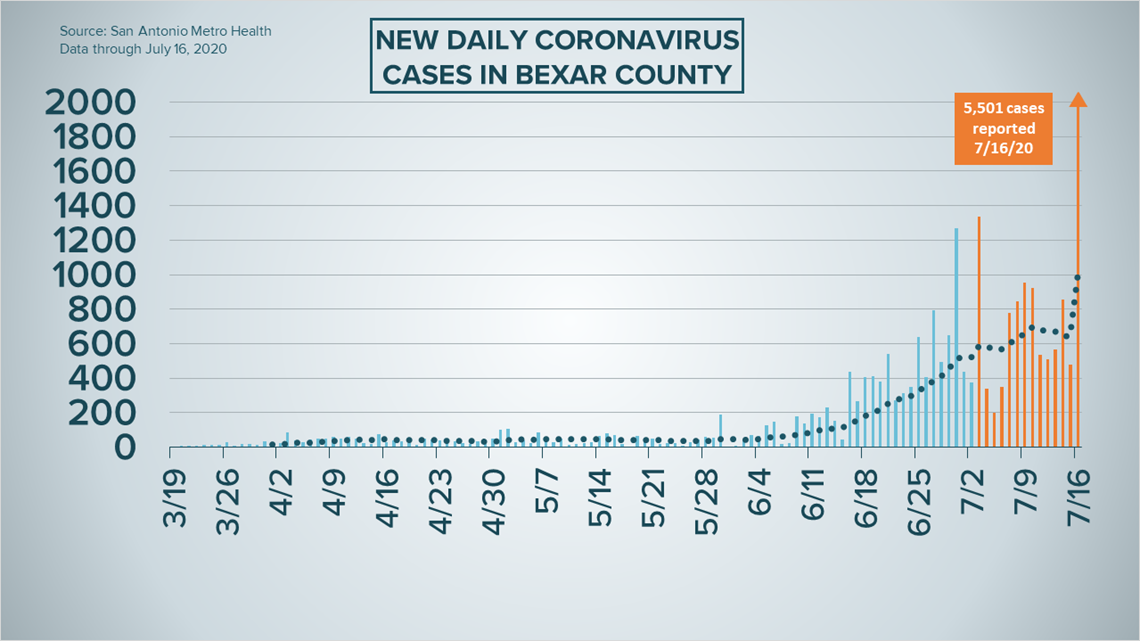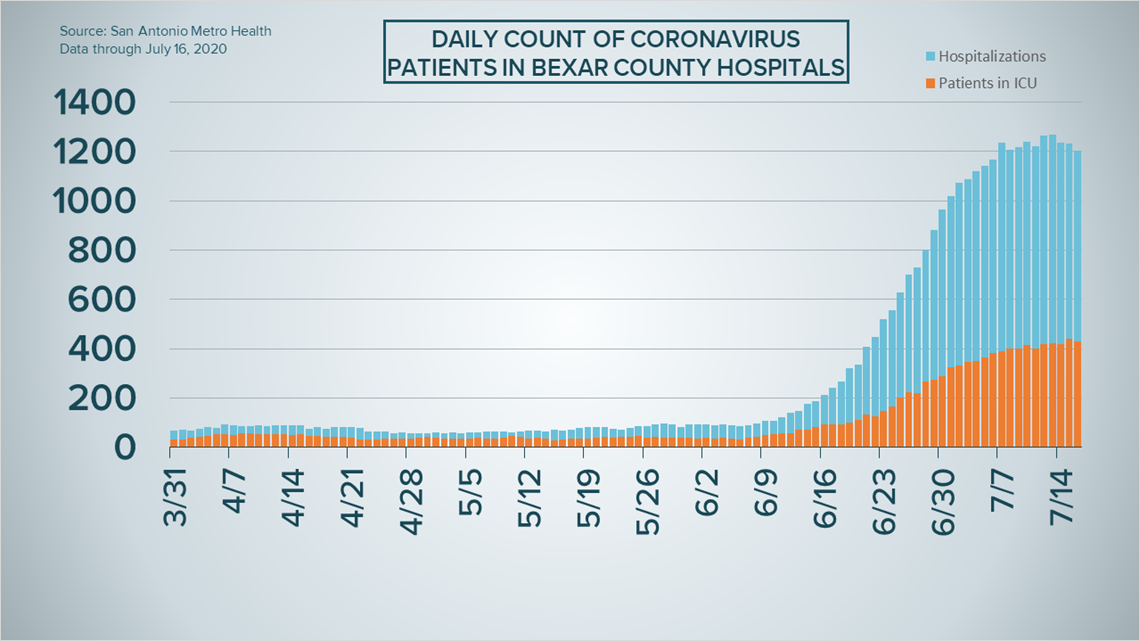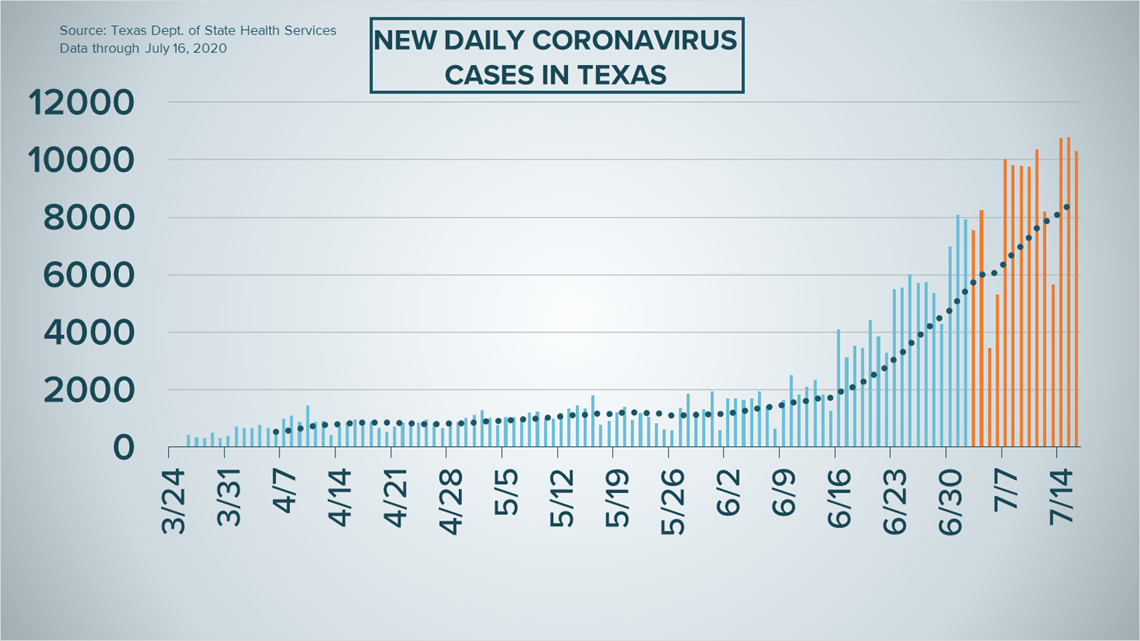SAN ANTONIO — We're tracking the latest numbers from the coronavirus pandemic in San Antonio and across Texas. Here are the latest numbers reported by Bexar and surrounding counties:
- Bexar County: 5,501 cases and 29 fatalities from COVID-19 were reported Thursday. There have been a total of 27,047 cases and 229 virus-related fatalities in the county.
- Comal County: 90 new cases were reported Friday. There have been a total of 1,558 cases and 35 virus-related fatalities in the county.
- Hays County: 47 new cases were reported Thursday. There have been a total of 3,816 cases and 14 virus-related fatalities in the county.
How Bexar County is trending:
We're tracking how many coronavirus cases are confirmed in Bexar County each day from the time San Antonio Metro Health began reporting cases more than two months ago. Graphing those daily case numbers along a 14-day moving average provides an accurate picture of the curve in the San Antonio area and the direction we're heading amid the coronavirus.
On Thursday, Mayor Ron Nirenberg reported an additional 5,501 coronavirus cases in Bexar County. Of those, 691 are considered "new cases" by health officials, while the remainder were attributed to a "backlog of reporting."
Mayor Nirenberg explained the backlog means that new cases counts were underreported over the last week or so. The state notified patients of their testing results within 3 to 4 days of administrations, but "kinks in the communication process between State and Metro Health" led to testing results not being reported. Mayor Nirenberg said those kinks have been resolved.


There is now a total of 27,047 coronavirus cases in Bexar County. 21 more virus-related deaths were reported, raising the local death toll to 229.
1,202 patients remain hospitalized in Bexar County medical facilities. 430 patients are in ICU, while 227 patients are on ventilators. The number of available beds in Bexar County rose to 12 percent, while 46% of the county's ventilators are available,


San Antonio Metro Health reports the full daily numbers at 7 p.m.
Coronavirus in Texas
State health officials reported 10,291 newly confirmed coronavirus cases Thursday and an additional 129 virus-related deaths were reported in the state, marking the second day in a row that Texas has reported an all-time high daily fatality number. Those figures bring the statewide totals to 292,656 COVID-19 cases and 3,561 deaths.




More than 133,151 Texans remain ill with the virus, while an estimated 155,937 residents have recovered.
Latest Coronavirus Headlines
- Northside ISD: School year to start with distance learning for all
- North East ISD to use distance learning for first three weeks of school year
- COVID-19 is surging inside Texas nursing homes, state data shows
- No lockdown needed if Texans follow mask mandate, governor says
- Health officials clarify how 'probable' coronavirus cases are reported in Bexar County
- VERIFY: COVID-19 vaccine syringes to have trackers on the outside, not in vaccine
Coronavirus symptoms
The symptoms of coronavirus can be similar to the flu or a bad cold. Symptoms include fever or chills, cough, shortness of breath or difficulty breathing, fatigue, muscle or body aches, headache, new loss of taste or smell sore throat, congestion or runny nose, nausea or vomiting and diarrhea, according to the Centers for Disease Control.
Most healthy people will have mild symptoms. A study of more than 72,000 patients by the Centers for Disease Control in China showed 80 percent of the cases there were mild.
But infections can cause pneumonia, severe acute respiratory syndrome, kidney failure, and even death, according to the World Health Organization. Older people with underlying health conditions are most at risk.
On June 25, the CDC expanded the list of groups at a higher risk of severe illness due to coronavirus.
Experts determined there was consistent evidence these conditions increase a person's risk, regardless of age:
- Chronic kidney disease
- COPD (chronic obstructive pulmonary disease)
- Obesity (BMI of 30 or higher)
- Immunocompromised state (weakened immune system) from solid organ transplant
- Serious heart conditions, such as heart failure, coronary artery disease, or cardiomyopathies
- Sickle cell disease
- Type 2 diabetes
The CDC believes symptoms may appear anywhere from two to 14 days after being exposed.
Human coronaviruses are usually spread...
- Between people who are in close contact with one another (within about 6 feet).
- Through respiratory droplets produced when an infected person coughs, sneezes or talks. These droplets can land in the mouths or noses of people who are nearby or possibly be inhaled into the lungs.
- Some recent studies have suggested that COVID-19 may be spread by people who are not showing symptoms.
Help stop the spread of coronavirus
- Stay home when you are sick.
- Eat and sleep separately from your family members
- Use different utensils and dishes
- Cover your cough or sneeze with your arm, not your hand.
- If you use a tissue, throw it in the trash.
Lower your risk
- Wash your hands often with soap and water for at least 20 seconds. If soap and water are not available, use an alcohol-based hand sanitizer.
- Avoid touching your eyes, nose, and mouth with unwashed hands.
- Avoid close contact with people who are sick.
- Clean and disinfect frequently touched objects and surfaces.
- The CDC recommends wearing a mask or cloth face covering if you have to be out due to an essential service or essential activity such as going to the grocery store.
- If you are 60 or over and have an underlying health condition such as cardiovascular disease, diabetes or respiratory illnesses like asthma or COPD, the World Health Organization advises you to try to avoid crowds or places where you might interact with people who are sick.

